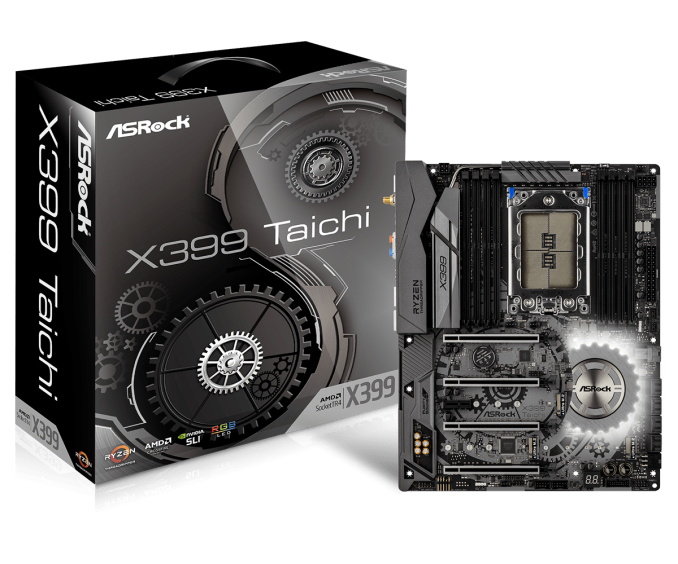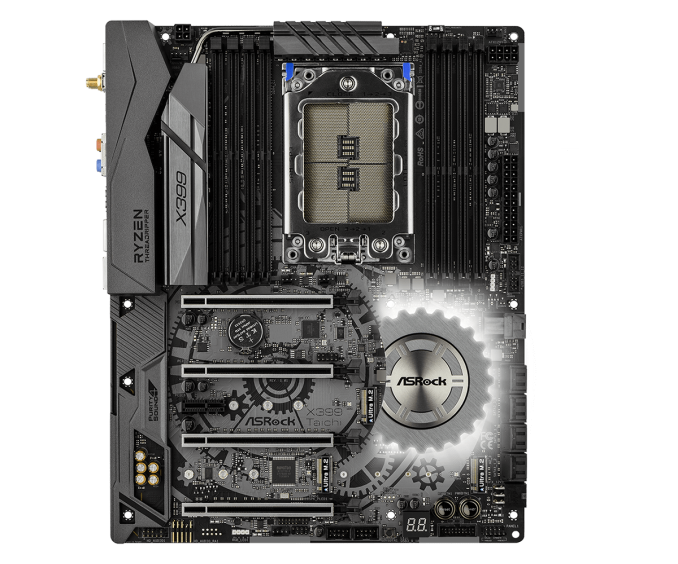An AMD Threadripper X399 Motherboard Overview: A Quick Look at Seven Products
by Ian Cutress & Joe Shields on September 15, 2017 9:00 AM ESTASRock X399 Taichi
The X399 Taichi is configured at a lower point down the ASRock product stack from the Professional Gaming. The Taichi forgoes 10 Gigabit Ethernet, and instead of the Creative Sound Blaster Cinema 3 suite for audio the Taichi uses Purity Sound 4 and a Realtek ALC1220 Codec.
Normally we associate ASRock’s Taichi models with black and white, but this time ASRock has made the board white and grey and drawing attention to the fact that the LEDs can be white if needed. So this means the X399 Taichi has a black PCB with gray accents in the shape of cogs on the PCB area between the PCIe slots and around the chipset heatsink. The DRAM slots are black, while the dual heatsinks for the VRM stretch around to the rear IO via a heatpipe are gray. Much like the Professional Gaming, the only integrated RGB LEDs are under the chipset heatsink, although there are two RGB LED headers for connecting additional RGB strips, all of which can all be controlled by the RGB LED application bundled with the board.
Just like the Professional Gaming, the Taichi supports up to 4-Way SLI and 4-Way Crossfire, with the PCIe slots reinforced using ASRock’s ‘Steel Slot’ protection. From top to bottom, the PCIe slots offer x16/x8/x16/x8 connectivity, taking 48 of the 60 PCIe lanes from the chipset. The final twelve are dedicated to storage with three onboard PCIe 3.0 x4 M.2 slots, one of which is switched with a U.2 connector. Other storage connectivity comes from eight SATA ports, supporting RAID 0/1/10.
The X399 Taichi uses two Intel I211AT gigabit Ethernet controllers, as well as an Intel 3168 1x1 802.11ac WiFi module.
In an almost copy-paste of the Pro Gaming, the Taichi uses the same digital 11 phase IR solution, along with the same EPS placement on the board. USB connectivity on the Taichi is the same as well, with three USB 3.1 (10 Gbps) Type-A ports on the rear panel, one USB 3.1 (5 Gbps) Type-C port on the rear panel, two onboard USB 3.1 (5 Gbps) headers for the front panel, and two USB 2.0 headers as well.
| ASRock X399 Taichi | |
| Warranty Period | 3 Years |
| Product Page | Link |
| Price | $339.99 |
| Size | ATX |
| CPU Interface | TR4 |
| Chipset | AMD X399 |
| Memory Slots (DDR4) | Eight DDR4 Slots, up to 3600 MT/s Supporting 128GB Quad Channel |
| Network Connectivity | 2 x Intel I211AT GbE |
| Wireless Network | 802.11 ab/g/n/ac Dual-Band (2.4/5 GHz) Bluetooth 4.2 |
| Onboard Audio | Realtek ALC1220 |
| PCIe Slots | 4 x PCIe 3.0 (x16/x8/x16/x8) from CPU 1 x PCIe 2.0 x1 from Chipset |
| Onboard SATA | 8x Supporting RAID 0/1/5/10 |
| Onboard SATA Express | None |
| Onboard M.2 | 3 x PCIe 3.0 x4 - NVMe or SATA |
| Onboard U.2 | 1 x PCIe 3.0 x4 (disables M2_1 when in use) |
| USB 3.1 | 1 x Type-A, 1 x Type-C (Rear Panel) |
| USB 3.0 | 8 x Rear Panel, 4x via internal headers |
| USB 2.0 | 4 x via internal headers |
| Power Connectors | 1 x 24-pin ATX 1 x 8-pin CPU |
| Fan Headers | 1 x CPU (4-pin) 1 x CPU Opt/Water Pump (4-pin) 2 x Chassis (4-pin) 1 x Chassis Opt/Water Pump (4-pin) |
| IO Panel | 2 x Antenna Ports 1 x PS/2 Mouse/Keyboard Port 1 x Optical SPDIF Out Port 1 x USB 3.1 Type-A Port 1 x USB 3.1 Type-C Port 8 x USB 3.0 Ports 4 x USB 3.0 Ports 2 x RJ-45 LAN Ports w/ LED 1 x BIOS Flashback Switch HD Audio Jacks |















99 Comments
View All Comments
Holliday75 - Friday, September 15, 2017 - link
Where is this magical land?ddriver - Friday, September 15, 2017 - link
Actually, many people in the developed world call a technician for even trivial things like changing a fuse. Building a computer, as simple as it is, is out of this world achievement in their eyes.mapesdhs - Tuesday, September 19, 2017 - link
Weird, normally such a person wouldn't even ask a relevant question. My gf doesn't care what my HTPC has inside, as long as it runs YT and plays DVDs, etc. ok, and she can use the wifi link to find stuff for her Kindle.mapesdhs - Tuesday, September 19, 2017 - link
NB: I was replying to ddriver saying, "So a dumb wife having to approve your purchases is a realistic scenario? :D".Vatharian - Friday, September 15, 2017 - link
No anything that has more than 2 HDDs is a server. I also have gaming PC that has 10 HDDs. They are low capacity, and connected to low-end HBA, but this way I won't ever lose any data. And I just can't think of a reason to pay well over $1000 for 10 disk-capable NAS.ddriver - Friday, September 15, 2017 - link
You really must love noise then, and waste power. Besides, the more drives, the more drives, the higher the odds some of them die. You can get a couple of large HGST drives, huge capacity, excellent reliability. The odds of both drives failing is minuscule, and would require the entire system burning up, which would be just as devastating regardless of many drives you have. You don't require 10 drives for the sake of the number. 10 TB HGST HE10 are like 350$.Besides, TR doesn't fall neither in the "budget", nor in the "gaming" category. That's a workstation CPU, and it actually does pretty bad in gaming, considering its price. Paying that much money for a product you are not gonna use for the job it is best at and complaining the mobo doesn't fit your senseless and wrong usage scenario - that's kinda dumb.
It is a new high end product, you are gonna put new high end components in it, not 10 poor old tiny HDDs.
Guwapo77 - Saturday, September 16, 2017 - link
It's not bad at gaming, however, it is not wise to use this solely for gaming. A workstation that you can use to handling your day to day workload that just happens to be fairly decent for gaming when you have time.Anyone building a gaming rig that chooses to buy a TR fails at life.
cyberguyz - Thursday, December 28, 2017 - link
It has 2x M.2 slots not 3x. You need an add-in card to get the 3rd with this onefazalmajid - Sunday, September 17, 2017 - link
Annoying, but a LSI add-in HBA will generally outperform integrated SATA by a wide margin.karatekid430 - Thursday, October 26, 2017 - link
Ask the manufacturers to make M.2 PCIe cards with a SATA controller and a heap of SATA ports on board. I want them to provide these, and exclude SATA from motherboards, to save space and reduce complexity and cost. That way, the motherboards are cleaner for people who only require NVMe, and allow for people who need SATA to sacrifice M.2 slots for SATA.